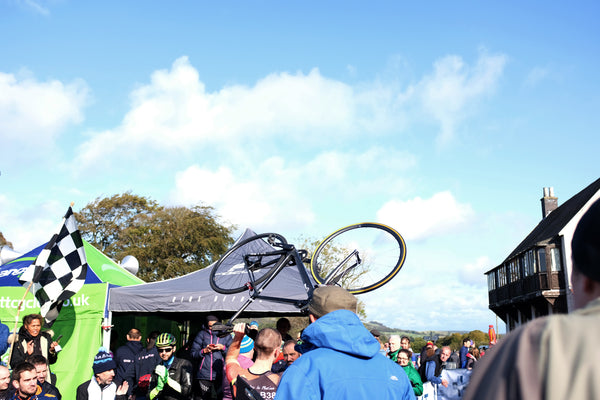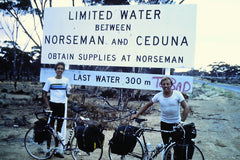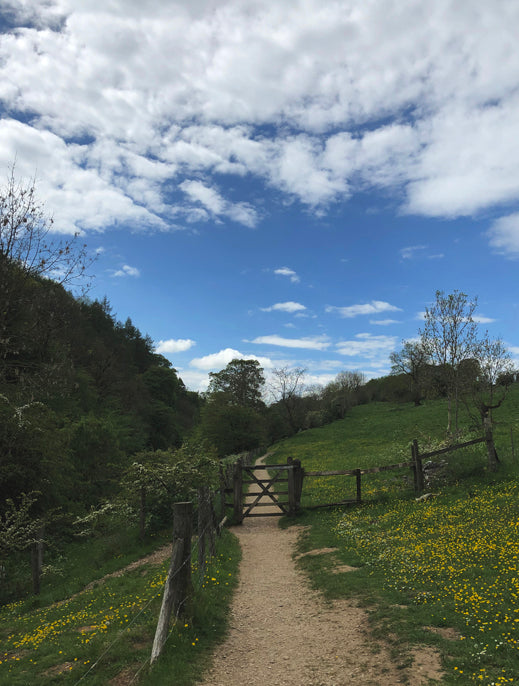For my friend Steve.




James Knox is a Britsh rider with a very bright future! Born in Cumbria in the North-West of the UK, it comes as no surprise that he is somewhat of a climbing specialist.
After riding for both Zappi and Team Wiggins between 2014-2017 he announced that he was turning professional in 2018 and is currently riding for UCI WorldTeam Deceuninck-Quick-Step.
James has already ridden two grand-tours (Giro d'Italia and Vuelta a Espana) in 2019.
Many thanks to James for completing the Mamnick quiz.

As a racing cyclist, which results are you most proud of and why?
I guess I'm proud of all my results, step by step they've improved over the years and I've come a long way since I started in 2012. Can't really argue that the 11th overall at La Vuelta is the peak for me at the moment, could never have imagined I'd be able to say that.
Which are your favourite stretches of road to ride on locally and what is it that you like about them?
Plethora of lovely roads I grew up riding on, it's hard to choose, but my first rides were from mine (just outside Kendal) to my Granddad's in Kirkby Stephen. My dad would get us to ride over since I was quite little. The roads from Sedbergh or over Barbondale and Dentdale to get there are beautiful, plus it's nearly always a taily too and there's barely any traffic unlike the lakes.
The same question for roads anywhere in the world?
I was pretty impressed with the Dolomites when I've raced there... Hard to beat West Coast of Scotland too.

What is your most memorable moment on the bike or involved with cycling?
Probably the day I found out Quickstep wanted to sign me in 2017, I'd been blindly chasing this dream for a few years by this point and guess it hit me pretty hard when I realised one of the biggest teams in the world had offered me a contract.
Has racing affected your relationship with the bike? If so, how?
That's a tough one, maybe I'm a bit more aware of the risk now because of a few years of racing. Hardly feels worth it smashing down descents or whatever in training when you know you've got to put on the line in a race next week. Not sure what else has changed, maybe an extra appreciation for being able to park up and have a café stop after a couple hours instead of hacking on.
Do you agree with Mickey Goldmill's advice to Rocky that 'women weaken legs'?
Mickey Goldmill's probably not far off the money, my mentor Flavio Zappi told me early on that energy needs to be spent training, not chasing.
We are in the midst of a well publicised boom in cycling in the UK at the moment. Has it affected you? Do you have any thoughts about why it has happened and whether it will continue? Do you see any negatives to the increase in popularity?
Honestly, it hasn't really affected me an awful lot, I grew up in a cycling family even if I didn't take up racing until I was a bit older so it did seem a bit peculiar when suddenly cycling became more mainstream. I remember whilst at secondary school of at least 1000 pupils there were only 3 of us who paid any interest in cycling, me, my brother and a technology teacher who was a local racer, and that was it. Wiggins winning the Tour and the London Olympics changed that overnight. It's great more people are cycling but it feels like local events are struggling so that's disappointing, if you called yourself a cyclist 10 years ago it meant you turned up to your local 10 and evening crit. The obvious negative is the conflict on the roads, more people cycling seems to create a bigger issue for people in cars, especially now there's probably worse percentage skilled and road aware cyclists kicking about. Shouldn't be a big issue but everyone's in a rush aren't they.

All cyclists, whether they race or not, seem to obsess over the weight of their bikes. Why do you think this is?
Everyone likes to feel fast don't they, doesn't matter what ability you are.
Do you approach riding, or ride your bike, differently now to when you first got into cycling?
Not massively, I still love being out on the road, the simple pleasures of finding new roads or doing a big loop. Not someone who worries about numbers or efforts so the bulk of my training is just riding and giving it a nudge every now and then.
Who has been your favourite pro riders over the years and why?
I was a fan of the sport before I started racing so there's been plenty of riders I've admired over the years. To pick just a few, Contador made a big impact on me when he exploded onto the scene in 2007, dancing on the pedals without any seeming effort, something I dreamed of replicating I guess. I found myself rooting for Joaquim Rodriguez a lot too, something about his punchy style and diminutive stature was just so cool. Philippe Gilbert as well, just raw power out of the saddle and was never afraid to take the race on, even if it might cost him the win. Another rider with style you'd want to try and pull off in training too, pretty mad that we ended up as teammates after watching him win everything in 2011. Finally, Oscar Freire, read some articles about him and just found thought he was mystical, managed to get lost all day before winning worlds, barely trained and wouldn't see him in a race before he shot out of the bunch at 150m to go. Go watch the 1999 world championship in Verona on YouTube, up there as one of the best finishes ever to a bike race, 8 of the best riders in the world watching the unknown at the time Freire ride off at 800m to go and unable to do anything about it, so good.
What was you favourite era of professional bike racing?
Probably the years that I first started watching, the post Lance years basically. The first races I properly remember are Bettini doing the double at World's then Lombardia, crossing the line full in tears and head to toe in the world champs stripes, what a time to start watching.
What is your favorite piece of cycling kit (either something you currently own or have in the past)?
I bought a pair of Oakley M-frames off ebay when I was 17 or so, the one's that didn't bend, I was so made up with them.
What do you think about Strava?
Yeah, I'm into it. It's great for finding new roads, plotting big days and I use the times on climbs as reference for training.
What do you think about Sportive rides?
Don't want to shoot myself in the foot if I become a sportive rider or set up my own in the future, but right now I don't really get it, for quite a few reasons. My dad does a couple each year, normally the Fred Whitton and he says it gives him a reason to ride when he might sack it off when we get into a discussion about it, so taking that into account, I can't knock it too much.
Do you have any cycling pet hates?
Tiny handpumps that put in a couple psi per stroke, what a wind up they are.
Are there any cycling traditions that you think have been, or are being, lost as a result of changing attitudes and behavior? And are we better off or worse off as a consequence?
Hmmm, I'm not maybe a huge traditionalist so this isn't easy for me. I've noticed this trend of power meters and coaches taking over though, every 16 year old thinks they need minute by minute training and numbers set, don't really get where that's come from and it's made so many people restricted to what they do. Enjoy riding your bike first and foremost, everything else will come eventually.
Cotton cap or helmet?
Cotton cap is definitely the style option, but I've been raised to wear a helmet so I would never go training without it.

The benefits of spinning a low gear compared to mashing a high gear is often discussed. Putting aside the serious, physiological and mechanical aspects, what cadence you think looks right?
I'm a smaller side so I end up spinning a bit more to keep up I feel, but I wish I had a bit more gas to turn a bigger gear. 75rpm has a nice look to it.
What do you like to talk about when you are on a ride with friends/team/club mates? Do you prefer to keep the subjects lightweight or get your teeth into something contentious or controversial?
Bit of everything, quite enjoy getting my teeth stuck into something meaty to pass the time, I prefer to train with people for company and a good natter makes the whole process more enjoyable.
Which three words best describe you?
Small. Man. Syndrome.
Did you used to listen to music before a race? If so, did you have a favourite tune or playlist?
I have a TT warm-up playlist and that's it. Just some different techno and disco tunes to get me in the mood, finishing with 'Glue' by Bicep. I don't do a proper warm-up, I just ride as easy as I can and let the nerves do their thing anyway, so the music helps a lot.
When were/are you most happy?
Sat in just my chamois sunbathing at the cafe, when applicable of course, that's a happy place. Fanta Limón ready to slide down my gullet, can almost taste it just thinking about it.
Who would be your guests at your perfect dinner party (dead or alive)?
Maybe get Ricky Gervais, Steve Merchant and Karl Pilkington round for a curry, keep it light hearted. Guess it would be foolish to pass the opportunity to get the few of the Knox lineage out as well, speak to some great Grandparents and beyond I never got to meet. Impossible question if we're being honest, too many options.
If you could go back in time, where would you go?
I'd go back and see the dinosaurs getting wiped out.
When was the last time you cried?
I cried over the line on stage 20 of the Vuelta, not sure why and wasn't thinking I'd be infront of the camera's at the time. The whole race just sort of hit me at that moment, a wave of euphoria and pain all in one, it was all too much.
When did you laugh the hardest?
Not sure, I laugh a lot I think, hard to remember what at.
Are you the type of person who likes to have a plan? Or do you prefer to wing it?
I prefer to wing it, unless it's something serious, then I can't survive without a plan.

If you could edit your past, what would you change?
Nothing, it's all there to be learned from.
Actually, I won my first big race at the Junior Tour of Wales in 2012, we were all watching Geordie Shore in my team and we had a joke that if someone won a stage they had to do that Gaz pose with his thumb to his nose. Don't know if anyone remembers this or watched the shoe, I ended up winning and delivered on the promise, it'd be nice to know I never did that. I also squirted a gel at junior rider when he wouldn't give me a turn when I was younger, what a little runt I was/am.
What single thing would improve the quality of your life?
I'd throw my smart phone against the wall and get something that I could only use to ring people, use WhatsApp and email and that's it.
Continue reading



































It's hill climb season and one of the main attractions on the calendar is the Monsal Hill Climb at Monsal Head, Derbyshire.
First run in 1930, this has been a fixture in the diary of those who enjoy the pain-cave for an amazing 89 years!
Malcolm Elliott holds the current record that has stood since 1981 ~ 1:14.2
Will it ever be broken? Not this year!








All photos by Thom Barnett
Continue readingThere is sometimes something new to be found in something old. I have always enjoyed the camaraderie and tales that come with riding with a cycling club - we all love a good story and if it involves the bike then even better!
Whilst out riding with the famous Sheffield club Rutland CC I've heard numerous stories during cafe-stops including fights in fancy dress, drunken shenanigans and the odd 'epic' ride.
One story that kept popping up was the round the world trip of four Rutland members back in 1980, so I got in touch with one of these men, Malcolm Pearce to see if he could shed anymore light on it for me.
What transpired during this trip, along with Malcolms photos are now published below. Enjoy!
__________________________________________________________________






































I've explored these parts many times on the road bike, both the road and rough-stuff from the top of Beeley Moor. I've noticed a few footpaths and bridleways that I thought would be worth checking out on foot.
The influence of Chatsworth house on the surrounding villages of Pilsley, Edensor and Beeley can be felt in this area, for over two centuries Beeley was effectively an estate village belonging to the successive Dukes of Devonshire.
Many of the properties now have been sold-off but the village pub, The Devonshire Arms, has been brought back into the Duke's control in recent years. Formally three separate cottages, these were knocked together. King Edward VII and Charles Dickens are both said to have stayed there and this is where we started our walk.


The first part of the route leads up through the plantations, running next to Beeley Brook and Moor Farm, before opening up across the open fields of Beeley Moor. From there you can visit Hob Hurst's House, a Bronze age burial mound named after a mischievous goblin (or giant) which lives in the nearby woods.
Dropping back down into the woods across Beeley Brook you cross the road and take the bridleway for approx 1 mile, eventually encountering the remains of industry in the woods just beyond Fallinge Farm. As early as the mid-1600s a lead smelting mill has been established on the hillside, fuelled by coal dug from a seam on Beeley Moor.


Once you leave the woods you cross several fields and across numerous wall stiles, heading back towards the village. The Devonshire Arms serves Jaipur, or you can nip in The Old Smithy Cafe for homemade cakes and tea.
Start + Finish ~ Grid Reference SK265676
All words and photos by Thom Barnett
Continue reading“Lathkill is, by many degrees, the purest, the most transparent stream that I ever yet saw either at home or abroad…” ~ Charles Cotton, 1676

If you park at the Lathkill Hotel at Over Haddon as we did, you can walk down the winding lane to the Lathkill lodge, or you can ride here but you’ll need a change of shoes in your saddle bag, or cycling shoes that are ok for walking (the route is approx 8 miles).
Before you reach the lodge, you will turn right onto this beautiful limestone dale next to the River Lathkill. Down here, there is a scene of ash trees, growing beneath limestone crags, scree and pastel coloured grassland. You’ll notice the crystal clear stream and if you stop to inspect, you may even spot some darting trout.

Lead miners came here in the 18th and 19th century, some of the mine caves are still there for you to inspect. They drilled shafts and adits into the rock and built pump houses, aqueducts, waterwheels and even tramways. Due to overseas competition, the price of lead slumped and by 1870, the pistons stopped.
There are remnants of that time here, the Peak District’s industrial past, now surrounded by lush plants. The valley is full of sycamore and ash trees. Amongst them you’ll see the mossy pillars, remains of the aqueduct built to supply water to the Mandale Mine which is close by. You can cross the river in places, a nice bridge allows you to inspect Bateman’s House, the former mining managers dwelling.


I have since been told that in dry periods of summer, the river disappears completely beneath the bed of limestone to be replaced by purple orchids, cowslips, primrose-like flowers and rock rose. Although, truth be told, I’ve never witnessed it.
When you exit this twisting valley you will arrive at Monyash. Here you will find a pub ‘The Bulls Head’ and a cafe ‘The Old Smithy’, a popular cycling destination for local riders. The pub once held the miners special Barmote Court.


The return leg of the walk is along high pastures overlooking the valley that you’ve just walked through, via Cales Dale and Calling Low this is know as the Limestone Way. You can nip through Meadow Place Grange to get back to the lodge where you started your walk.
If you want to make a weekend of it, there is Haddon Hall nearby, home of the Duke of Rutland. One of the finest and unspoilt medieval manor houses in England and used as a location for countless films and tv drama including Jane Eyre and Price and Prejudice.


All words by Thom Barnett
Photos by Lulu Watson
Continue reading